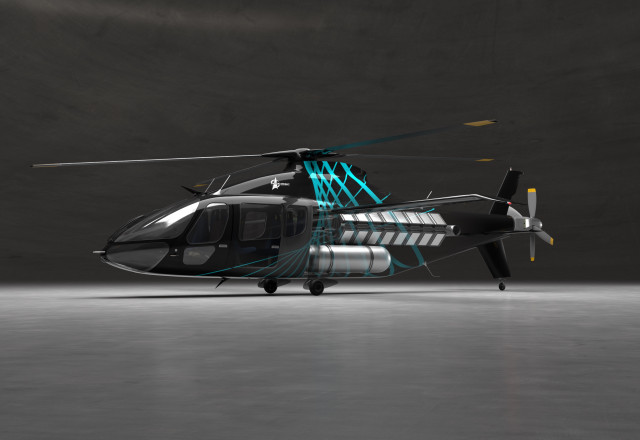Piasecki back in the gAAMe

Piasecki Aircraft Corporation has bought the Pennsylvania-based former Lockheed Martin Sikorsky Heliplex facility as it eyes a return to aircraft production.
With a legacy stretching back 80 years, Piasecki launched the US’ second helicopter, the PV-2, in 1943 as well as the world’s first tandem rotor helicopter, which lives on in Boeing’s CH-47 Chinooks, shortly after. Now the firm has revealed plans to renovate a 219,000sqft former Sikorsky facility in order to further research and develop new technologies. These include: advanced digital flight control and flight automation technology, hydrogen fuel cell and hybrid propulsion systems and morphing aerostructures. One example of that technology is Piasecki’s PA-890 hydrogen fuel cell-powered helicopter (pictured below) which will be built and tested at the Coatesville site in Pennsylvania.
The facility – which includes engineering development, aircraft assembly, paint and finishing and a production flight test and delivery centre – will open its doors to employees towards the end of this year. For the past few decades Piasecki has been validating manned and unmanned aircraft technologies for the US Department of Defense (DoD). Making this move a major step in expanding operations from flight research alone to producing practical applications, according to John Piasecki, president and CEO.
“Right now the vertical lift industry, both in the military and the civilian sector are going through transformative developments where Piasecki technology has direct relevance,” he tells Revolution.Aero. “On the military side with the shift to the Indopacom [United States Indo-Pacific Command] peer-to-peer environment and potential threats, the need for vertical lift mobility is dramatically expanded. And it’s mobility that has to have the speed and range that goes well beyond a traditional helicopter. Then, on the civilian and commercial sector there is a huge push for electrification and a reduction of fossil fuel emissions and parallel demand for reduced costs. Usually those two don’t go hand-in-hand.”
Having watched the commercial drive towards battery powered aircraft for the past decade or so, Piasecki concluded the technology does not have the energy density required to satisfy the needs of today’s helicopter market. That is where the PA-890 was born. “So, what we’re doing is focusing on the development of aviation grade hydrogen fuel cell propulsion that can support the PA-890, which is a platform that can meet those existing market needs,” says Piasecki. The firm signed a deal with HyPoint in 2020 to research hydrogen fuel cell options, which in turn has led to Piasecki working with ZeroAvia after it acquired HyPoint in October last year. However, the low-temperature fuel cells touted for use in fixed-wing applications require heavy cooling systems that are not suitable for vertical lift aircraft where every gram counts. Piasecki, ZeroAvia and HyPoint are developing a high-temperature stack with no need for a cooling system. Labelled as “breakthrough technology” by developers, it could offer up to three times the specific power of low-temperature fuel cells. The OEM estimates with 13,000 light helicopters in operation that comes to about $40bn worth of inventory. Paying customers that are more than likely to need a replacement at some point. “The Coatesville move allows us to have multiple development programmes going on at the same time so we can exploit those opportunities,” he adds.

Piasecki notes the market opportunities are reliant on the technology being realised, however using NASA technology readiness levels (TRL), a type of measurement system used to assess the maturity level of a particular technology, the team will be over halfway to completion by the end of the year. Having completed successful lab tests with HyPoint and ZeroAvia, Piasecki is preparing to flight test on a co-axial helicopter testbed later this year. These tests will take the technology from a TRL4 to a TRL5 and TRL6. “Then scaling it up from that 80kw system to 660kw will be done over the next three years on a full end-to-end propulsion test rig, called an iron bird,” says Piasecki. “This will validate the technology for the PA-890 aiming to certify around 2028. Which in aviation terms is tomorrow.”
A year in the planning, Piasecki chose to expand in the Delaware Valley largely because of the region’s connections to the helicopter industry. Speaking on the move US Representative Chrissy Houlahan from Pennsylvania’s 6th congressional district, said: “Chester County is home to some of the most talented manufacturing and tech workforces in the country. It’s incredibly exciting to see a company like Piasecki, a long-time aviation industry innovator, continue their commitment to developing new technologies like the PA-890 hydrogen fuel cell-powered helicopter right here in PA’s sixth district.”
Piasecki added: “One of the primary motivations in selecting this facility is the talent pool that is the southeastern Pennsylvania area and in Coatesville specifically. Sikorsky had some 2,000 employees at the peak of their production at this facility, so there is a very large pool of skilled, talented workers that are being under-employed right now in the area.”
Although the financial details of the deal have not been disclosed, the investment Piasecki has made to get back in the production game is significant. Sikorsky originally purchased the plant in 2014 for $17.9m. It is a calculated risk, but one the Piasecki leadership believes is worth taking. In terms of the PA-890 we will know by 2028. But for any Pennsylvanian helicopter engineer hoping to dust off the overalls, this is good news today.






